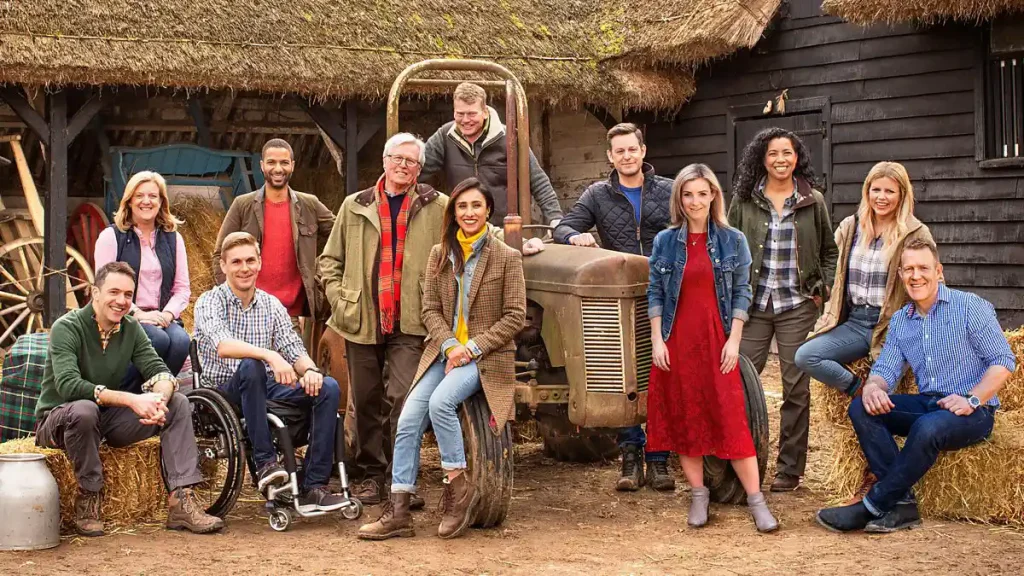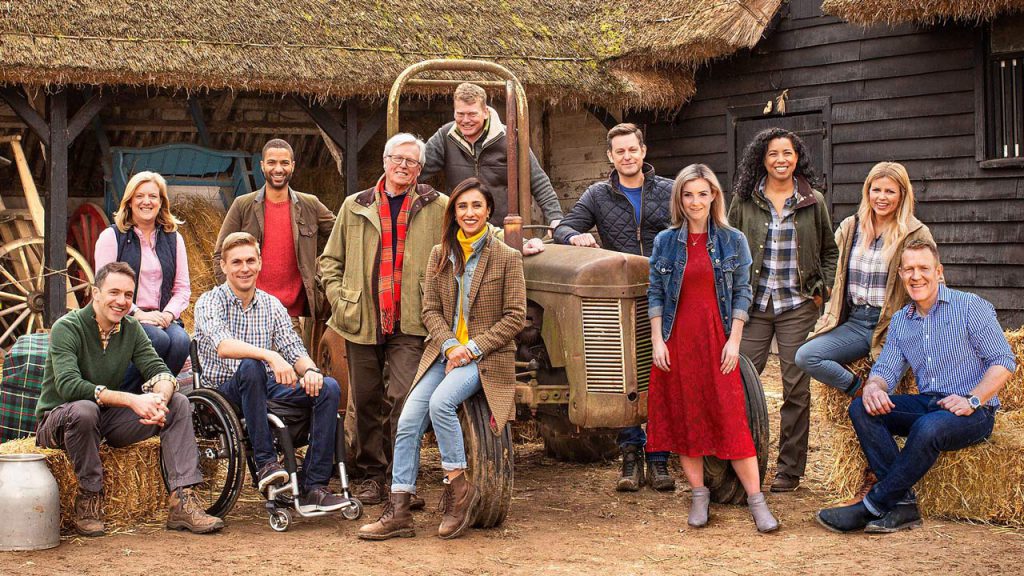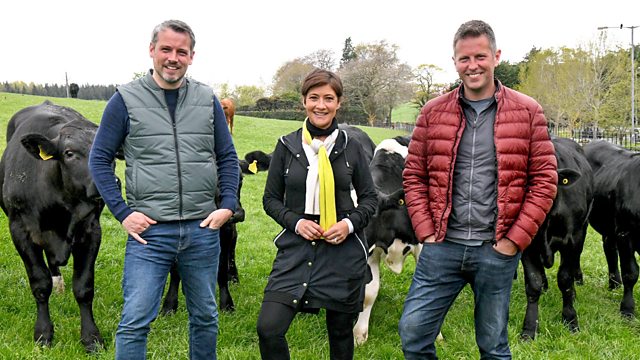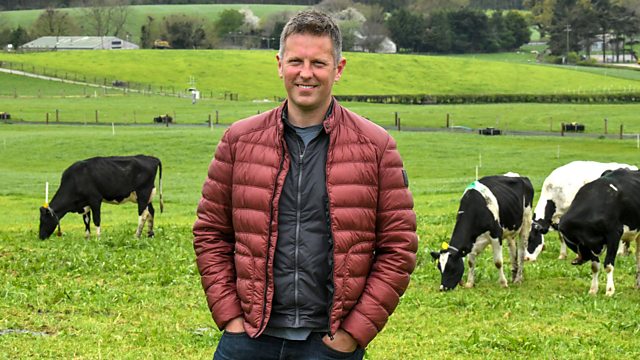Countryfile – Dumfries House – It’s been three eventful months since Countryfile’s last visit to the historic Dumfries House estate in Scotland, where King Charles III spent much of his time before ascending to the throne. Now, in the height of summer, Matt Baker and Charlotte Smith return to see how life on the 2,000-acre grounds has changed since the King’s coronation.
Matt discovers that the estate has become busier than ever, with expanded programs aimed at improving the mental and physical wellbeing of local residents. He joins a lively tea dance hosted by the estate, where locals of all ages swing and sway to music. For many participants, these dances provide a sense of community and help combat isolation and loneliness. Later, Matt heads to the farm to learn traditional rural skills like animal husbandry. He helps the farm staff conduct health checks on the livestock and gains hands-on experience caring for the animals.
Meanwhile, Charlotte dives into the art of stained glass window making in the estate’s workshop. This medieval craft is being taught to preserve historic techniques. Charlotte tries her hand at selecting and cutting the colored glass pieces and soldering them into a decorative window. She also puts some finishing touches on a charming birdwatching hide she helped construct during her last visit. The hide allows visitors to quietly observe the many species of birds that flock to the grounds. Charlotte also learns about the estate’s plans to increase sustainability. There are proposals to reuse, refurbish, and re-engineer old wind turbines on site to generate greener energy.
With expanded community outreach programs, new learning opportunities, and a commitment to conservation, Dumfries House continues to grow and evolve under the stewardship of King Charles III. Matt and Charlotte discover the estate has found new purpose in serving the public good and honoring Scottish heritage. Though change is afoot, the heart of Dumfries House remains its dedication to enriching lives and preserving the past for future generations.
Countryfile – Dumfries House
The summer sun shone brightly over the sprawling grounds of Dumfries House, casting everything in its warm glow. It had been three months since Countryfile’s last visit to the royal residence, when the estate was abuzz with preparations for the King’s coronation. Now, a sense of relaxed joy filled the air as visitors immersed themselves in all that this historic place had to offer.
Matt Baker was delighted to be back at Dumfries House, eager to discover what new activities and events were in store. As he walked up the gravel driveway, he could already see people gathering on the great lawn, preparing for a lively tea dance. Matt quickly made his way over to join in, keen to experience how this traditional pastime was benefiting the local community.
Uplifting Spirits Through Dance
The tea dance was in full swing when Matt arrived, with couples gracefully sweeping across the dancefloor. An elderly gentleman named Bertie, who Matt had met on his previous visit, waved in recognition. Bertie went on to explain how attending these weekly dances had become a highlight for many older residents, helping combat loneliness and inactivity. The physical exercise boosted heart health, while the social interaction lifted people’s moods. For those who had lost loved ones, the friendly atmosphere also eased grief.
As Matt listened, it was touching to see firsthand how joining in song and dance could profoundly improve wellbeing. The steps and rhythms drew people out of isolation, forging new friendships and support networks. Watching Bertie joyfully twirl his partner to the music, Matt understood why he enthused about how tea dances had given him a new lease on life. When the song finished, Bertie encouraged Matt to try it for himself. Stepping tentatively at first, soon Matt was fully swept up in the delight of the dance.
Passing On Rural Skills
After an invigorating morning on the dancefloor, Matt headed to the farmyard, eager to immerse himself in some hands-on agriculture. Here, Dumfries House offered workshops for local youth groups to gain farming knowledge spanning animal husbandry to crop cultivation. Matt was welcomed by the farmer Jack, who was giving a lesson on safely handling livestock.
As the teenagers gathered around a penned sheep, Jack patiently explained techniques on restraining the animal for health checks and hoof trimming. Matt joined in assisting, learning how to gently but firmly direct the sheep. He was impressed by Jack’s clear and encouraging teaching style, designed to build the teens’ confidence. It was inspiring to see these rural skills being passed down, ensuring this precious practical wisdom was not lost.
With the lesson finished, Jack gave Matt a tour of the farmyard. They stopped to admire the cows contentedly grazing in the pasture, while chickens pecked in the hay strewn across their coop. Matt left feeling connected to the land, with a deepened appreciation for all the hard work that went into sustaining a farming legacy.
Crafting Beauty in Stained Glass
While Matt was down on the farm, Charlotte Smith headed to the craft workshops, where students were diligently piecing together works of art. Returning to the stained glass classroom, she was amazed to see the bird hide mural she had helped design last spring now magnificently completed. The rich jewel tones of the glass caught the sunlight, illuminating the details of feathers and fronds.
Charlotte was introduced to the stained glass teacher Stella, who explained the intricate process behind this age-old craft. First, the design is traced onto sheets of glass. Next, specialized pliers are used to carefully cut and shape the pieces. Finally, everything is joined together using the copper strips of lead cames. Charlotte was honored when Stella asked her to add the final pane to the bird hide mural. With steady hands, she secured it in place, stepping back to admire the finished tableau.
Stella then offered Charlotte a lesson in creating her own stained glass piece. Starting with a simple floral pattern, Charlotte followed each step, gaining appreciation for the precision and artistry the work required. She was thrilled to end up with a beautiful little sunflower suncatcher, able to better understand now why stained glass had decorated churches and cathedrals for centuries. The way it captured light was truly magical.
Building a Sustainable Future
In addition to traditional crafts, Charlotte learned of Dumfries House’s commitment to cutting-edge sustainability. In the estate workshops, there were plans to refurbish old wind turbine parts rather than scrapping them. By creatively reusing these materials, they aimed to substantially reduce waste.
Charlotte spoke with the workshop manager Neil, who outlined how they would re-engineer the turbine blades into sculptural benches and shelters. The worn gearbox components would also be transformed into decorative features around the grounds. Neil explained that by giving the parts new life, they were upholding the values of reuse and conservation intrinsic to long term environmental stewardship.
This ethos aligned perfectly with Dumfries House’s extensive green initiatives, from solar fields to reforestation projects. Charlotte came away feeling heartened that places like this were leading the way in building a brighter future. Where some only saw debris, they recognized opportunity. It was a reminder that often the sustainability solutions we need are already right in front of us. We simply require the vision to turn the old into something new.
Bringing People Together
Reflecting on her day at Dumfries House, Charlotte felt greatly inspired. In every workshop and far-flung corner of the estate, she saw people connecting with heritage, creativity, nature and community. The programming provided enriched the lives of both locals and travelers alike.
Whether learning a rural trade or finding joy in dance, the activities here imparted meaningful purpose. Set within the historic grandeur of the grounds, Dumfries House created an oasis to nourish the mind, body and spirit. Charlotte knew this was a place she would revisit many times, always finding something special to appreciate.
Most of all, she was touched by the way Dumfries House gathered people in celebration of the rich traditions of the past, while pioneering solutions for a more harmonious tomorrow. It was a testament to the power heritage places hold to bring us together through even the most challenging of times. If the smiles witnessed here were any indication, Dumfries House was sure to remain a beacon of hope and heart for generations to come.
Conclusion
Visiting Dumfries House with the Countryfile team offered an uplifting glimpse into how heritage sites can profoundly enrich communities. From the restorative joy of the tea dances to the promise of a sustainable future, this historic estate has become a hub for connecting people with time-honored traditions as well as trailblazing innovation.
Most importantly, Dumfries House provides a welcoming space for locals and visitors alike to learn new skills, forge friendships, and improve their wellbeing. The programming on offer has demonstrated the power heritage places hold to unite us through shared human experiences that span across the ages. By safeguarding precious history while fearlessly striding ahead, Dumfries House stands as an inspiring embodiment of the past and future coming together in harmony.
FAQ – Countryfile – Dumfries House
**What activities does Dumfries House offer?**
Dumfries House provides a wide range of activities including traditional tea dances, rural skills workshops, craft classes, sustainability initiatives, and events. There are programs to enrich physical, mental, and social wellbeing.
**How does attending a tea dance benefit people?**
Attending the weekly tea dances at Dumfries House helps combat loneliness and inactivity for many older residents. The physical exercise is good for their heart health, while the social interaction lifts people’s moods. It creates a support network and forges new friendships.
**Why is teaching rural skills important?**
Passing down traditional rural skills helps ensure this precious practical wisdom is not lost. The workshops at the farmyard teach local youth about livestock care, animal husbandry, and crop cultivation. Learning these skills fosters an appreciation for the land and hard work involved in agriculture.
**How is stained glass made?**
The intricate process involves first tracing the design onto sheets of glass, then carefully cutting and shaping the pieces with specialized pliers. Finally, everything is joined together using the copper strips of lead cames. It is an age-old craft requiring precision and artistry.
**What sustainability initiatives is Dumfries House pioneering?**
Dumfries House is committed to cutting-edge sustainability, like plans to refurbish old wind turbine parts rather than scrapping them. This reduces waste by creatively reusing materials. It aligns with their ethos of reuse and conservation for environmental stewardship.




